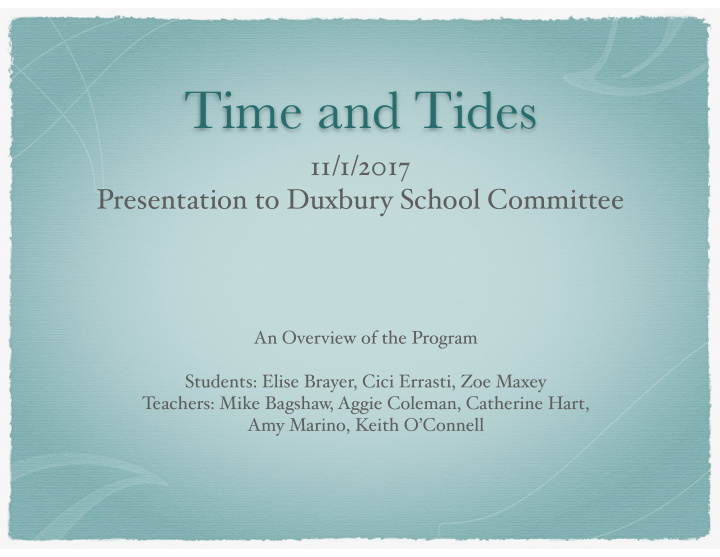



Time and Tides 11/1/2017 Presentation to Duxbury School Committee An Overview of the Program Students: Elise Brayer, Cici Errasti, Zoe Maxey Teachers: Mike Bagshaw, Aggie Coleman, Catherine Hart, Amy Marino, Keith O’Connell
Thinking About Education If you were in charge of designing a new high school experience, what would it be like? What would stay the same? What needs to change?
Thinking about Education A recent headline from The Boston Globe Magazine: Another from NPR:
Thinking About Education And from The New Y ork Times Magazine:
Thinking About Education What are the current strengths and challenges at Duxbury High School? How would an interdisciplinary program improve the overall student learning experience?
Our Vision Time and Tides is a multidisciplinary program joining students and faculty together to expand the understanding of ourselves and our world in Duxbury. W e collaborate in combining science, math, art, and the humanities as we explore global and local locations, topics, and themes. W e see this as an opportunity to pioneer what will become an innovative class at DHS. As students begin to make connections, they become increasingly capable of asking better questions. As students discover their own distinct voices, they become more e ff ective in providing feedback to both peers and faculty. Students will leave the program with not only the tools, but also the drive, to leverage learning in the service of other individuals and organizations; in essence, students will be better prepared to shape and improve the world in which we live.
School within a School Thematic units based on “big” questions, connected to the community out of the classroom Not just cross curricular - truly interdisciplinary Students create Unit Synthesis Assignments and teach a portion of a unit Community Stewardship is essential
Background Rivers and Revolutions - Concord - Carlisle Regional HS Site Visits: Fall 2014 - Fall 2017 - students, teachers, and administrators to Concord and W ellesley Professional Development W orkshop - Building Communities - July 2015: Amy Marino, Keith O’Connell, and Catherine Hart Curriculum W ork - with Students Fall 2016 - Present Pilot Programs - Summer 2015 & Summer 2017
So . . . Why Duxbury? Time and Tides
Time and Tides Pilot Program 2015 Theme chosen: ROOTS - How can we know anything if we can’t know everything? Cultural roots - Plato’s A ! egory of the Cave Historical roots - Duxbury and our ancestry Scientific roots - trees and their growth Mathematical roots - measurement
Time and Tides Pilot Program 2017 Expanded on the theme of Roots and adapted our essential question: How does where we are a ff ect who we are? W orked with Island Creek Oysters Explored Duxbury Bay with the help of the DBMS
Time and Tides - Future? A semester course for 12th - grade and 11th - grade students Developmentally appropriate for upper grades The interdisciplinary framework allows time to plan, to reflect, and to create Students - especially in our high - pressured world - need a way to pause, to readjust the way in which they learn This type of program helps a school build community by changing how students approach their learning
CCHS - R & R Data (Based on 3 years, 2 Cohorts per year) Students found they are more engaged in their learning during high school ( 94 %) and in college ( 93 %) Students found an increase in motivation to learn ( 94 %) and confidence in class ( 88 %) Students found they were more comfortable collaborating with peers and providing feedback ( 95 %) Students were able to connect their learning to the real world ( 97 %)
Time and Tides 2015 Created by Brendan McCarthy and Owen MacDonald
Time and Tides - Future Together, faculty and students have been meeting to develop these curriculum ideas for next year: Roots - How do our roots influence our place in our community and vice - versa? Bridges - What is the relationship between creation, destruction, and change? Channels - How has humanity channeled technology to a ff ect the social and physical environment? Time - How is time both a human creation and a natural occurrence?
Unit Design - An Example Bridges - What is the relationship between creation, destruction, and change? Humanities: How does language bridge cultures? time periods? - translations, journaling, multicultural essays Math : geometry -- how do bridges hold weight? Science : Duxbury Bridge! science of engineering - building but also decay STEM : How does geometry help engineers build bridges? Project - Build a Bridge Main Text : Hart Crane’s “The Bridge” Sites : Our Bridge; Lennie Sakim Community - Visit with Bridge Engineers - Our Bridge issues
Recommend
More recommend